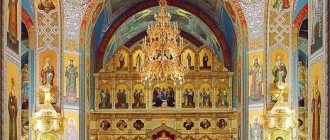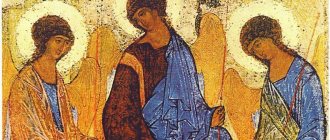ORTHODOX SACRAMENTS,
sacred rites established by divine providence, revealed in Orthodox church rites, through which invisible divine grace is communicated to believers. In Orthodoxy, there are seven sacraments, the seven gifts of the Holy Spirit: baptism, confirmation, Eucharist (comunion), repentance, the sacrament of the priesthood, the sacrament of marriage and the consecration of oil. Baptism, repentance and the Eucharist were established by Jesus Christ himself, as reported in the New Testament. Church tradition testifies to the divine origin of other sacraments.
Sacrament of Baptism
Essence:
A person enters the Church and receives a new, spiritual birth. Until a person is baptized, he remains completely under the power of original sin, but in baptism the person’s way of being changes. He unites with Christ and overcomes dependence on original sin. Without accepting the sacrament of Baptism, a person cannot receive other church sacraments. It can be performed only once; the Creed says about this: “I believe in one baptism for the remission of sins.”
Biblical Reasons:
The sacrament was established by Jesus Christ.
The Gospel of John says: Jesus answered, “Truly, truly, I say to you, unless one is born of water and the Spirit, he cannot enter the kingdom of God”
(John
3
:5).
He Himself was baptized by John the Baptist (Matthew 3
:15-16) and after His resurrection He sent disciples to preach and baptize:
Go therefore and teach all nations, baptizing them in the name of the Father and the Son and the Holy Spirit
(Matthew
28:19
) .
Story:
In apostolic times, people were baptized immediately, with virtually no preparation. Then, from the 2nd century, the practice of catechesis, the preparation of adults for baptism (which took place twice a year, at Christmas and Easter), was established. As a separate divine service, the rite of Baptism developed later.
About the Sacrament of Baptism on the Thomas website
Seven sacraments of the Orthodox Church
are designed to fill the seven most essential needs of a person’s spiritual life. The sacraments of baptism, confirmation, communion, repentance and consecration of oil are considered obligatory for all Christians. The sacrament of marriage and the sacrament of priesthood provide for freedom of choice. The sacraments are also divided into repeatable and non-repeatable during a person’s life. Only once in a lifetime are the sacraments of baptism and confirmation, as well as the sacrament of the priesthood, performed. The remaining sacraments are repeatable.
Sacrament of Confirmation
Essence:
Through anointing with sacred myrrh, a baptized person is given strength to overcome sin and live according to the commandments.
Biblical Reasons:
The Sacrament of Confirmation has its basis in the Gospel:
On the last great day of the feast, Jesus stood and cried out, saying: If anyone thirsts, let him come to Me and drink.
Whoever believes in Me, as the Scripture says, out of his belly will flow rivers of living water. This He said about the Spirit, which those who believed in Him were about to receive: for the Holy Spirit was not yet on them, because Jesus was not yet glorified (John
7
:37-39), and also in the apostolic epistles:
However, you have the anointing of He who is holy and you know everything
(1 John
2:20
),
but He who establishes you and me in Christ and anointed us is God
(2 Cor
1:21
).
Story:
The Council of Laodicea decided to perform this sacrament immediately after Baptism in 343 A.D.
About the Sacrament of World Knowledge on the website of “Thomas”
CATHEDRAL OF ST. JOHN THE BRANCHESTER
- Baptism
- Confirmation
- Repentance
- Eucharist
- Priesthood
- Marriage
- Blessing of Unction
Roman Catholics defend the idea that it is enough for a certain sacrament to be performed by a legally appointed clergyman and according to the established order for it to have an effect on a person.
In this understanding, the sacraments approach almost some kind of magical actions that produce one or another change in human nature without much participation on his part. In contrast to the Latin view, Protestants attribute all the power and significance of the sacrament exclusively to the internal disposition, the faith of the person receiving this sacrament. Faith is everything here. Lack of faith turns the sacrament into an empty, meaningless formality. Therefore, in the most important of the Christian sacraments - the sacrament of the Eucharist - they reject the transubstantiation of bread and wine into the true body and blood of Christ. Bread remains bread, wine remains wine; but “in the bread, with the bread and under the bread, Christ is invisibly present,” and he who approaches the sacrament with faith - through the communion of bread and wine, actually takes into himself the body and blood of Christ, while he who does not have the appropriate mood eats ordinary bread and wine. Of the other sacraments, Protestants accept only baptism. They reject all other sacraments or equate them with simple rites - on the grounds that there is supposedly no clear evidence in the Holy Scriptures regarding their Divine establishment.
Baptism.
Roman Catholics and Protestants (Baptists and Pentecostals are an exception) perform baptism not through immersion, but through pouring and sprinkling. All Christian antiquity speaks in favor of the practice of the Orthodox Church - complete threefold immersion in water. Christ Himself was baptized through immersion; the first preachers of Christianity baptized through immersion (see Acts 8: 37-38); the immersion is evidenced by special baptismal chambers adapted for this purpose, which are still preserved in some ancient temples in Rome and other places in the West; immersion corresponds to the main idea of the sacrament: immersing three times in the font, the baptized person is buried in Christ into death and then rises with Him into eternal life (Rom. 6:4). During Orthodox baptism, the words are pronounced: “The servant of God (name of the rivers) is baptized in the name of the Father, Amen, and the Son, Amen, and the Holy Spirit, Amen.” In the 15th century, Catholics changed this formula and since then Catholic priests, pouring water on those being baptized, say: “I baptize you...”.
Sectarians consider infant baptism an unjustified addition to the teachings of Jesus Christ.
The Holy Spirit, who guides the life of the Church, does not make mistakes in His actions. So, it was by the inspiration of the Holy Spirit that the practice of infant baptism was established. The Baptist assertion that the original practice of the Christian Church was to baptize only adults who consciously accepted the faith is a weak argument that has no confirmation in church history. If the practice of infant baptism was an innovation, how did it spread everywhere and become established in both the Christian East and West without causing any resistance on the part of Christians? After all, the believers of the first centuries were incomparably more zealous and strict in relation to both religious issues and church practice than current members of the Church. If infant baptism were a new thing, it could only be established after great controversy, as a result of struggle, and perhaps even division. However, the history of the Church does not tell us anything about disputes among Christians regarding infant baptism. Objections to infant baptism first appeared in Germany in the 16th century from the Anabaptists. What happened in all these 15 centuries after the birth of Christ? Is it really possible to seriously believe that the entire Universal Church has torn itself away from Jesus Christ because of the baptism of children?
The baptism of children has been universally known since the times of the apostles. The book of the Acts of the Apostles repeatedly tells that the apostles baptized entire families, and therefore children. To deny the baptism of children by the apostles, it is necessary to assume that in all these cases, in these families baptized by the apostles, there were no children, which would be a big stretch, especially if we take into account that childless families in those days were a rare phenomenon. After all, Christianity is intended to be the soul not only of the lives of individuals, but also of family life. The baptism of children is an expression of this. Christ Himself says that only those born of water and the Spirit will be able to enter the Kingdom of God (John 3:5), and this obliges us to bring children into His Kingdom. This means that we can and should be confident in the appropriateness of the custom of baptizing infants, established by the apostles, according to the testimony of the great scientist of Christian antiquity, Origen, who wrote: “The Church received from the Apostles the tradition of baptizing children.”
In the first centuries of Christianity, the Church was still in the missionary stage. With her word, sermon and sacrament of Baptism, she primarily addressed adults. But, having established the ground under Her, She looks at the children born in Her womb as Her own children. Protopresbyter Alexander Schmemann writes about this in his book on baptism “By Water and the Spirit”:
“A newborn child belongs to the family. It does not have any autonomous existence; his life is completely determined and shaped, both in the present and in the immediate future, by this affiliation. And the family - if it is a Christian family - belongs to the Church, finds in the Church the source, content and transcendental purpose of its existence as a family. Therefore, a child who belongs to the family and, in a more specific, biological sense, to the mother, thereby belongs to the Church, is truly her child, already offered, entrusted to God.”
Objecting to the baptism of children, some sectarians argue that infants, children of Christians, have already been washed and cleansed by the Blood of Christ, therefore there is no need to cleanse them in baptism from the sin of Adam: their sins are forgiven for the sake of the merits and name of Jesus Christ. In addition, opponents of infant baptism refer to the commandment of Christ given to His disciples: “Go and teach all nations, baptizing them in the name of the Father and the Son and the Holy Spirit” (Matthew 28:19), believing that from these words it supposedly follows that The apostles were commanded to baptize only those who had learned and believed, but not infants.
But Scripture clearly teaches that, according to the word of the Apostle Paul, in Adam all sinned (Rom. 5:12). Consequently, children, having no personal sins, are still not free from original sin, from the inheritance of Adam, and in order to get rid of this inheritance, they must unite with Christ, and this union, as we have already said, is accomplished in the sacrament of Holy Baptism. “Behold, I was conceived in iniquities, and my mother gave birth to me in sins,” King David exclaims with sadness in Psalm 50. In order to cleanse a child from original sin, in order to sanctify him and thereby introduce him into the Kingdom of Heaven, where, as it says in verse 27, chapter 21 of the book of the Apocalypse, “nothing unclean will enter,” children have been brought through this cleansing in the sacrament for two thousand years holy baptism. People who deny children the sacrament of baptism endanger them, for if children die before baptism, not being born of water and spirit (John 3:5), how can they inherit eternal life? Of course, we believe in the mercy of God, and also in what Christ said: “What is impossible with men is possible with God, but why tempt the Lord?”
The reference to the words of the Savior in the Evangelists Matthew and Mark in favor of the opinion that Christ allegedly commanded to baptize only adults who have conscious faith is also unfounded because these words are not relevant to the issue of infant baptism. Just as the evangelical paralytic received forgiveness of sins and healing through the faith of those who brought him to Christ, just as the daughter of a Canaanite woman received healing through the faith of her mother, so children receive cleansing from original sin through the faith of those who brought them to the baptismal font to unite the baby with Christ in the sacrament of baptism. We must also not forget that the sacrament of baptism established in the New Testament replaced the Old Testament rite of circumcision, which was a prototype of holy baptism, and children were subjected to this rite. To this day, Jews perform this ritual over their children. Just as through circumcision, those who underwent it became a member of the Old Testament chosen people and entered into a covenant with God, so all those who are baptized become members of the New Testament people of God, members of the body of Christ - His Church. Why should children remain outside the Body of Christ?
Confirmation.
Among Catholics, the sacrament of anointing (confirmation) can only be performed by a bishop, who lays his hand on the believer and imprints the cross of St. on his forehead. peace and says: “I sign you with the sign of the cross and confirm you with the peace of salvation in the name of the Father and the Son and the Holy Spirit. Amen". Removing priests from this sacrament, Catholics refer to the fact that Philip, having baptized the Samaritans, could not impart the Holy Spirit to them, and for this purpose the ap. Peter and John (Acts 8:14-17); but Philip was a deacon, not a priest, and from here it is not yet clear that priests could not perform confirmation. Since both in ancient times and now in Orthodoxy, confirmation was united with St. baptism, we can rather conclude that it was performed not only by bishops, but also by priests, because the number of bishops was too limited. One retreat inevitably led to another in Catholicism. Since the bishop did not have the opportunity to be physically present at the baptism of every baby within his diocese, the sacrament of confirmation is separate from baptism and is performed at the age of adolescence (from 7 to 12 years); a bishop, traveling around his diocese, usually stops in one or another village or city and here at the same time confirms all baptized children. And since many children can die without waiting for confirmation, Catholic theologians, to reassure the believers, resorted to a new teaching - that the sacrament of confirmation is not absolutely necessary for salvation.
Repentance.
Roman Catholics, in addition to the resolution of sins in the sacrament of repentance, also allow the so-called “indulgences” (indulgence, indulgence.) Catholics teach that in order to satisfy the justice of God, a person, although forgiven in repentance, must suffer temporary punishments for his sins - here on earth, in various calamities, and after death - in purgatory. But since a person is weak and infirm, then, by condescension towards him, one can free him from these temporary punishments, according to the power of the overabundant merits of the Savior and the saints who make up the treasury of the church. The right to grant indulgences belongs to the pope, as the vicar of Christ on earth. At confession, priests diligently investigate the sins of the penitent and then impute to him as many good, extra-duty deeds performed by saints as are necessary to atone for the sins of the penitent.
Thus, the great sacrament of spiritual cleansing and grace-filled healing of the sinful soul took on in Catholicism the character of a judicial interrogation and a mechanical accounting of the actions of one person to another. Indulgences are usually not given away for free, but are often sold for money - under the pretext, of course, of doing good deeds with the money. The selfish distribution of indulgences served as the main reason for the separation of Lutherans and Reformers from the Roman Catholic confession.
Some people confuse the completely different Orthodox and Catholic approaches to “penances” (Greek “penance” - punishment) and the practice of the Roman Church to issue indulgences with penance.
In the language of church canons, penance means the voluntary performance by the confessor, as prescribed by the confessor, of certain works of piety (prolonged prayer, alms, intense fasting, pilgrimage, and the like). Penance does not have the meaning of punishment, punitive measures, deprivation of the rights of a member of the Church; it is only “spiritual healing.” The rule of the Sixth Ecumenical Council reads: “Those who have received from God the power to bind and solve sins must consider the quality of the sin and the readiness of the sinner for conversion, and so use appropriate healing for the illness, so that, without observing measures in both, they do not lose the salvation of the ill person. For the disease of sin is not the same, but is varied and diverse, and produces many types of harm, from which the evil develops abundantly and further spreads until it is stopped by the power of the healer.”
“This shows the unacceptability of the Roman Catholic view on penance,” writes Protopresbyter Mikhail Pomazansky, “based on legal concepts, according to which: a) every sin, or sum of sins, must have church punishment (in addition to the fact that often disasters, for example, illness (as Catholics believe - V.P.), there are natural retributions for sin, so that often the sinner himself can see God’s punishment for sins in his fate); b) this punishment can be lifted by an “indulgence”, issued even in advance, on the occasion, for example, of anniversary celebrations; c) The Church, i.e. its head, the Bishop of Rome (Pope), when giving indulgences, imputes to the persons subject to penance the “merits of the saints,” taken from the so-called “treasury of good deeds.”
If some Western teachers of the ancient Church called penances satisfactions, they were called so only in a moral sense, as means for deepening the consciousness of sinfulness in the sinner, satisfactory for their purpose of educational, and not legal justification” (“Orthodox Dogmatic Theology”, Jordanville, 1963 ., p. 193).
Eucharist.
This sacrament is performed among Catholics, in essence, by one priest, according to his right, at the time when he, almost identifying himself with the Lord Himself, pronounces the “words of establishment.” In the Orthodox understanding, these words also have great significance, but the sacrament of transmuting bread and wine into the Body and Blood of the Lord is performed through the prayer of the entire Church, throughout the entire liturgy, and only ends with the invocation of the Holy Spirit.
Catholic doctrine also tries to overly rationalize the Eucharistic miracle itself with the help of scholastic concepts. According to this explanation, only the appearance of bread and wine remains unchanged, but their essence (substance) turns into the Body and Blood of Christ.
The Orthodox Church consciousness reverently refrains from such rationalistic penetration into the mystery. It is dominated by the conviction that bread and wine, while remaining themselves in appearance, at the same time become the Body and Blood of the Lord, just as red-hot iron becomes fire, and in the likeness of how the Lord Jesus Christ is both God and man.
O. Mikhail Pomazansky in his “Orthodox Dogmatic Theology” (p. 183) writes about this as follows:
“...Consecrated gifts 1) are not only signs or symbols that remind believers of redemption, as the reformer Zwingli taught, 2) and equally, Jesus Christ is not present in them only by His “action and power” (“dynamically”), as he taught Calvin; finally, 3) is present not only in the sense of “penetration,” as the Lutherans teach (who recognize the co-presence of Christ “with the bread, under the bread, in the bread”); - but the consecrated gifts in the sacrament are transfused, or (in a later term) transubstantiated into the true Body and true Blood of Christ, as the Savior said: “My flesh is truly food, and My Blood is truly drink” (John 6:55).”
Further about. Mikhail Pomazansky quotes words from the “Message of the Eastern Patriarchs” (18th century):
“We believe that our Lord Jesus Christ is present in this sacred rite, not symbolically - “tipikos”, not figuratively - “econikos”, not by an excess of grace, as in other sacraments, not by one influx, as some Fathers said about baptism, and not through the “permeation” of the bread, so that the divinity of the Word “enters” into the bread offered for the Eucharist essentially, as the followers of Luther rather inexpertly and unworthily explain: but truly and truly, so that after the consecration of bread and wine, the bread is broken, transubstantiated, transformed, transformed into the very true Body of the Lord, which was born in Bethlehem from the Ever-Virgin, baptized in the Jordan, suffered, buried, resurrected, ascended, sits at the right hand of God the Father, has to appear on the clouds of heaven; and the wine is transformed and transubstantiated into the very true Blood of the Lord, which, during His suffering on the cross, was shed for the life of the world. We also believe that after the consecration of bread and wine, it is no longer the bread and wine itself that remains, but the very Body and Blood of the Lord, under the appearance and image of bread and wine” (“Orthodox Dogmatic Theology”, p. 183). Among Roman Catholics, the Mass, at which a bloodless sacrifice is offered, is celebrated in two ways: either it is celebrated aloud, with singing and playing the organ, or it is read in a whisper, secretly. And since in Catholic churches there are several altars at the same time, the so-called “silent” liturgies are often celebrated simultaneously with the one that is served aloud, on the main altar. There were no “quiet” liturgies in Christian antiquity, and the simultaneous celebration of several liturgies in one church was not allowed.
The very transubstantiation of the Holy Gifts, according to Catholic teaching, occurs not during the blessing of them and the invocation of the Holy Spirit, as the Orthodox Church teaches and as ancient lists of liturgies testify (in the Catholic Mass there is no prayer of the priest at all for the invocation of the Holy Spirit), but during the utterance of words : “Take, eat”, “drink from it all.”
As the evangelists narrate, at the Last Supper the Lord first gave thanks, then blessed the offering of bread and wine, and then uttered the words “take, eat...”. From this it becomes clear that the transubstantiation was accomplished through prayer and blessing, and the words “receive, eat...” mean a simple appeal to the apostles to begin to receive the Holy Spirit. Gifts and indicate the mysterious meaning of the Eucharist.
A significant deviation from Orthodoxy also lies in the fact that the laity are deprived of the Holy Chalice, that is, they are deprived of communion of the most pure Blood of Christ, contrary to the direct words of the Lord: “Drink from it ALL.” This innovation was first introduced in the West in the 12th century, with the goal of demonstrating the superiority of the clergy over the laity in communion itself; it was then enshrined at the Council of Trent. To justify their retreat, Roman Catholic theologians came up with several excuses, such as that “there is no need for the laity to partake separately of the Holy Blood because where the Body is given, there the Blood is given,” or that “St. It’s easy to push the cup and spill it when there are so many people receiving communion.”
The correctness of the Orthodox way of performing the sacrament - under both types - is confirmed by the words of the Lord: “Truly, truly, I say to you, unless you eat the Flesh of the Son of Man and drink His Blood, you will not have life in you” (John 6:53). The teaching about the need for everyone to receive communion under two types is clearly expressed in the apostolic epistles (see, for example, 1 Cor. 10: 16-17 and Chapter 11: 26-30). And the patristic works testify against Roman practice. St. John Chrysostom (IV century) says - “we are all equally rewarded with the Body and Blood of Christ - not as happened in the Old Testament: some of the sacrifice was eaten by the priest, and some by the people. Nowadays it is not so, but one Body and one Cup are offered to everyone...”
Since small children cannot take solid food, the Catholics, having taken the Chalice from the laity, thereby completely deprived St. infant communion. This retreat did not appear earlier than the 12th century. Roman theologians give the following reasons: one must approach communion with an awareness of the importance and meaning of this sacrament and after proper preparation; there is no command in Holy Scripture to give communion to infants; One baptism is enough to save children. But communion of the Body and Blood of Christ serves as a means for us to unite with Christ, the Source of our spiritual life received in the sacrament of baptism. Catholics have blocked the way for infants to have close communication with the One who once said, “Let the little children come to Me and do not hinder them” (Mark 10:14).
The Eucharist among Catholics is celebrated not on leavened bread, as with us, but on unleavened bread, despite the fact that the very word “Artos”, used in the Greek text of the Gospel when narrating the establishment of the sacrament, means precisely leavened, leavened, risen bread. Catholics refer to the fact that the Savior supposedly performed the Last Supper on the first day of unleavened bread, and therefore on unleavened bread (wafers), which were consumed in accordance with the requirements of the Jewish law. However, from the story of Ev. John it follows that Christ celebrated the Last Supper the day before the Jewish holiday of Passover (John chapter 13), otherwise, how could the Sanhedrin judge Him the next day, Joseph of Arimathea buy the shroud, and the myrrh-bearing women buy incense? Since unleavened bread had a ritual significance among the Jews, Christ, having celebrated the Last Supper on leavened bread, thereby emphasizes that He abolishes the Jewish ritual law.
The use of unleavened bread, which became established in the West in the 11th century, led it to some other deviations from the tradition of the ancient Church. Since unleavened bread does not require special preparation at the liturgy, the entire first part of it, the proskomedia, was lost. Western Christians are thus deprived of the ancient church custom of commemorating before the Sacrifice of Christ all members of the Church, living and dead, and praying that their sins may be washed away by the true Blood of Christ, just as the particles of prosphora taken out for them are washed in the holy Eucharistic Chalice. When there is communion for the laity at a Catholic Mass, the priest, in addition to the main unleavened bread, with which he himself receives communion, also blesses other, small ones, one for each communicant. This custom contradicts the very concept of the unity of the Eucharistic Sacrifice; communion from the one bread has, according to the teaching of the Word of God, a deep dogmatic and moral meaning: “There is one bread, and we, who are many, are one body; for we all partake of one bread” (1 Cor. 10:17).
Priesthood.
Among Catholics, the Bishop of Rome is revered not only as the bishop and patriarch of the Western Church, but also as the visible head of the entire Christian Church.
In addition to the well-known sacred degrees, Catholics also have so-called “cardinals”. Initially, the bishops of the churches closest to Rome were so called, as friends and advisers of the pope, but then this distinction began to be given to the most honored persons in the Catholic clergy, and not only bishops, but also presbyters, and even deacons. The cardinal rank has especially risen since the 11th century, since the cardinals were given the exclusive right to elect a pope from among themselves.
In the Roman Church, celibacy (celibacy) was established for all persons of holy orders; it was introduced in the 11th century under Pope Gregory VII. The main basis for the establishment of compulsory celibacy by this pope was the following provision - “the church cannot free itself from subordination to the laity unless the clergy free themselves from their wives.” With the rise of papal power, there naturally should have been a desire to break the ties by which the clergy is connected with the family, and through it with the state; only a priest completely free from all family and civil ties and duties could serve in the hands of the Roman high priests as a reliable instrument for achieving their ambitious political plans.
The establishment of celibacy of the clergy, which had at least the apparent goal of raising the entire clergy to the heights of the Christian ideal of virginity, in reality should have led to concubinage. The beginning of that terrible debauchery and decadence of morals into which the Catholic clergy fell in the fourteenth and fifteenth centuries is to be largely sought in this unnatural demand of the Roman see. Wanting to put an end to such licentiousness, representatives of some Western churches proposed openly establishing concubinage for priests who were deprived of the opportunity to enter into legal marriage. Rome could not agree with these proposals and silently endured what it was unable to prevent, especially since some of the popes of the 14th and 15th centuries often surpassed the bishops and priests subordinate to them in immorality, which gave Savanarola a reason to preach the correction of the morals of the entire church, as its head and all its members.
Nowadays, Catholics are losing many priests who cannot stand a celibate lifestyle.
As for the Protestants, they do not and cannot have a legally ordained priesthood, since their apostolic succession ceased with the beginning of the Reformation - neither Luther nor the other reformers were followed by a single bishop. Protestant pastors, from the point of view of the Orthodox Church, are laity.
Marriage.
Catholics do not allow divorce under any conditions, even in the case of a violation of marital fidelity by one of the spouses, which contradicts the direct and clear teaching about this of Jesus Christ Himself, who said: “Whoever divorces his wife, except for the guilt of fornication, she has cause to commit adultery” (Matthew 5:32) and “Whoever divorces his wife for reasons other than adultery and marries another commits adultery; and he who marries a divorced woman commits adultery” (Matthew 19:9). In those cases where the spouses do not want or cannot live together, the Catholic Church tries to replace divorce or separation of the spouses, or - if the spouses certainly want to enter into a new marriage - by recognizing the first marriage as invalid.
Blessing of Unction.
Among Catholics, the consecration of oil is performed only on the dying and is therefore called the “last anointing.” In addition, according to Catholic teaching, the sacramental oil can only be consecrated by a bishop. Both teachings contradict the teaching of the Apostle James - “if any of you is sick, let him call the elders of the Church, and let them pray over him, anointing him with oil in the name of the Lord. And the prayer of faith will heal the sick person, and the Lord will raise him up; and if he has committed sins, they will forgive him” (James 5: 14-15) - this was the case in ancient church practice. Recently, Catholics have somewhat changed their attitude towards the “last anointing” and, under the influence of Orthodox theology, have come closer to our understanding of this great sacrament.
©V.Potapov, 1996-97
Sacrament of the Eucharist
Essence:
The prepared gifts, bread and wine, through the prayer of the Church become the Body and Blood of Jesus Christ, and Christians, by partaking of these Holy Gifts, join Christ, not symbolically, not speculatively, but really.
Biblical Reasons:
The sacrament was established by Christ himself.
In the Gospel of John, the Lord says: He who eats My flesh and drinks My Blood has Eternal Life, and I will raise him up at the last day
(John
6:54
).
On the eve of His death on the cross, He celebrated the first Eucharist at the Last Supper and gave communion to His closest disciples (Matthew 26:26
).
Story:
After the resurrection of Christ, these closest disciples - the apostles - went all over the world to preach the Good News, founded church communities, celebrated the sacrament of the Eucharist themselves and commanded the bishops and priests they appointed to perform it.
About the Sacrament of the Eucharist on the Thomas website
Ordination
Only clergy have the right to celebrate the Eucharist, as well as other Sacraments. The initiation of a simple layman into a clergyman is called “ordination.”
The prototype of the clergy were the apostles. The Gospel tells how the miraculous feeding of several thousand people with a small amount of loaves and fish took place. This is the prototype of the Eucharist, and the apostles here play the role of priests.
Ordination (ordination) happens:
- into the reader;
- to subdeacon;
- to deacon;
- to the priest;
- to the bishop.
Ordination is performed by a higher-ranking ecclesiastical person, usually a bishop. The patriarch himself ordains a bishop.
In this Sacrament, Grace is given to the clergy to shepherd the flock of Christ.
Sacrament of Confession
Essence:
A Christian orally or in writing in the presence of a priest (who in this case is a witness of the repentance offered to God) repents of his sins and receives forgiveness from the Lord.
Biblical Reasons:
The practice of confession has Old Testament origins (Judges
10:10
; Ps
50
; 1 Ezra
9
; Neh
1
:6, 7; Dan
9
: 4-19, 1 Sam
15
:24-25, etc.).
John the Baptist confessed the sins of the people who came to him to be baptized (Matthew 3
:6
).
But most importantly, the Lord directly speaks about this in the Gospel:
Jesus said to them a second time: peace be with you!
just as the Father sent Me, so I send you. Having said this, he blew and said to them: Receive the Holy Spirit. Whose sins you forgive, they will be forgiven; On whomever you leave it, it will remain on him (John
20
:21-23).
Story:
Regular confession originated in the early Christian Church. Initially, it was believed that confession should only be done once in a lifetime, but later the opinion prevailed that it should be done regularly.
About the Sacrament of Confession on the Thomas website
Validity and efficacy of the sacraments
The validity of the sacrament (that is, the fact that it in itself is a grace-filled, genuine power) depends on the external correctness of its performance. It is necessary to perform a sacred ceremony by a legally appointed hierarchical person, while observing a certain specific external form and verbal formula of the sacrament. The validity of a sacrament does not depend on the merits or merits of the persons performing and receiving the sacraments.
The effectiveness of the sacrament (that is, on the extent to which the recipient of the sacrament is honored with its grace-filled power) - in other words, its saving power, fruitfulness, renewing power - depends on how reverently a person approaches them. For the salvation of the sacraments, a person requires faith, consciousness of the great meaning and importance of the sacrament and, finally, a sincere desire and readiness to accept it. Unworthy reception of the sacraments may lead not to justification, but to condemnation, because grace does not restrict human freedom (1 Cor. 11:26-30). Often people who use the sacraments of faith do not receive from them what the sacraments can give: for the hearts of those who receive them are not open to grace, or people are careless about the gifts of God they have received. All the more remarkable are the miraculous manifestations of grace in holy people, who mysteriously receive God’s gifts and reveal in themselves the image of the deification of man.
In school theology one encounters a definition of the factors that ensure the validity of the sacraments as “objective”, and the effectiveness as “subjective”.
Sacrament of Anointing
Essence:
When anointing the body of a sick person with specially consecrated oil, the Grace of God is invoked upon him, healing from bodily and mental illnesses and those sins that a person cannot repent of due to his weakness.
Biblical Reasons:
The sacrament has its foundations in the New Testament.
Firstly, these are the words in the Gospel of Mark that the disciples of Christ anointed many sick people with oil and healed them
(Mark
6:13
).
Secondly, these are the words from the Epistle of the Apostle James: If any of you is sick, let him call the elders of the Church, and let them pray over him, anointing him with oil in the name of the Lord.
And the prayer of faith will heal the sick person, and the Lord will raise him up; and if he has committed sins, they will be forgiven him (James
5
:14-15).
It is important to know:
The Sacrament of the Blessing of Anointing, colloquially called unction, began to be understood differently among Orthodox and Catholics. Catholics call the Blessing of Anointing the “last anointing” and is performed only on terminally ill people. In Orthodoxy, Unction is performed not only in the event of a fatal illness. According to tradition, unction is supposed to take place no more than once a year.
About the Sacrament of Anointing on the “Thomas” website
Wedding
Photo: Hram-selo.cerkov.ru
The Sacrament of Marriage will mark the conclusion of a church marriage. It is noteworthy that not only laymen, but also lower church ranks (subdeacons and readers) can marry. When becoming a priest or deacon, a person must already be married or never marry again.
This sacred rite is called the Wedding, since crowns that look like royal ones are placed on the heads of the man and woman. This is a symbol of the Kingdom of Heaven.
After the completion of the Sacrament, its participants are considered husband and wife, according to church laws. Orthodoxy does not recognize divorce, so getting married to your loved one must be taken very seriously. You only need to choose your life partner once.
During this Sacrament, prayers are said in which married life is blessed by the Almighty, asking God for mutual understanding and peace in the family, and the birth of healthy children.
During the sacred rite, people receive God's Grace, which will help them maintain family peace, live in harmony, give birth and raise children. The marital union becomes a kind of prototype of the union of the church and the Savior.
Sacrament of Priesthood
Essence:
The ordination of a Christian to the priesthood, giving him the power to perform church sacraments and rituals. Only bishops as successors of the apostles can perform this sacrament. A person who is ordained a presbyter (i.e., a priest) receives the grace to perform the sacraments himself, but only with the blessing of the ruling bishop. And when consecrated as a bishop, the protege receives the grace not only to perform all the sacraments, but also to consecrate others to perform the sacraments - that is, he receives the fullness of apostolic power.
Biblical Reasons:
The priesthood was established in the Old Testament (after the Exodus from Egypt).
The New Testament, on the one hand, states that all Christians are priests to some extent (1 Pet 2
:9), on the other hand, it speaks of priests as a special ministry, as assistants to bishops (1 Tim
3
:2, Titus
1
:7; 1 Pet
2:25
), speaks of elevation to holy orders by the laying on of hands.
Story:
Preaching the Gospel, the apostles created church communities, the heads of which were made by bishops, who ordained elders to help them. Hence the concept of apostolic succession: each priest received ordination from a bishop, who, in turn, from another bishop - and so you can trace the entire chain of ordinations back to the 1st century, to the apostles.
About the Sacrament of Priesthood on the Thomas website
Unction
Photo: Hrampokrova-vrn.ru
This Sacrament is also called the Blessing of Anointing. It is performed in church or at home if a person is seriously ill. The main purpose of Unction is prayer for the healing of the believer from physical ailments. During the Sacrament, oil is blessed and used to anoint parts of the patient’s body. At this time, the Holy Scriptures, the Apostle and special prayers are read.
All this must be repeated seven times in a row. Unction received its name because initially seven priests participated in the Sacrament (hence the conciliar action, that is, joint prayer). Now the church does not prohibit one priest from performing the Sacrament.
( 6 ratings, average: 5.00 out of 5)
Literature
- Eusebius, Archbishop, Conversations on the Seven Salvations of the Orthodox Catholic Church
, ed. 5, St. Petersburg, 1872. - Ignatius, Archbishop. About the One, Holy, Catholic and Apostolic Church
, St. Petersburg, 1863. - Vozdvizhensky, M., priest, “On the T. Orthodox Church”, PO
, 1874, January, February. - Chrysanthus, archim., The nature of Protestantism and its historical development
, St. Petersburg, 1871. - Katansky, A., Dogmatic teaching about the seven church T. in the works of the most ancient fathers and writers of the church up to and including Origen
, St. Petersburg, 1877. - Svetlakov, A., priest. (Bishop Alexander), Exposition of the teaching of the Orthodox Church about the Church, church hierarchy, grace and T.
, Nizhny Novgorod, 1878. - Macarius, Met. Moscow, Orthodox Dogmatic Theology
, vol. 2, St. Petersburg, 1883. - Sylvester, ep., Experience of Orthodox Dogmatic Theology
, vol. 4, Kiev, 1889. - Uspensky, E., Accusatory Theology
, ed. 2, St. Petersburg, 1894. - Zaitsev, A., The number of sacraments of the Church
: - Sventsitsky, Valentin, prot., Dialogue fifth.
About the Sacraments :










